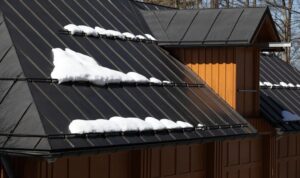Delving into the realm of fire-resistant roofing materials for safety, one uncovers a landscape filled with innovative solutions and practical benefits. From preventing fire spread to enhancing sustainability, these materials offer a unique blend of functionality and protection for homeowners and contractors alike.
As we navigate through the different types, installation processes, and environmental impacts, a clearer picture emerges of the crucial role that fire-resistant roofing materials play in ensuring safety and security.
Types of Fire-Resistant Roofing Materials

Fire-resistant roofing materials play a crucial role in protecting buildings from the devastating effects of fires. Let's explore some of the different types of fire-resistant roofing materials available in the market and their key characteristics.
1. Metal Roofing
Metal roofing, such as steel or aluminum, is known for its high fire resistance. These materials are non-combustible and can withstand extreme heat, making them a popular choice for fire-prone areas. Metal roofing is durable, long-lasting, and requires minimal maintenance.
It is often used in residential and commercial buildings in wildfire-prone regions.
2. Clay Tiles
Clay tiles are another type of fire-resistant roofing material that has been used for centuries. These tiles are made from natural clay and are inherently fireproof. Clay tiles have excellent insulation properties and can help regulate the temperature inside a building.
They are commonly seen in Mediterranean-style homes and buildings with a traditional aesthetic.
3. Asphalt Shingles with Fire Retardant Coating
Asphalt shingles are a popular roofing material due to their affordability and ease of installation. When treated with a fire retardant coating, asphalt shingles can enhance their fire resistance. These coated shingles can provide an additional layer of protection against flames and embers.
They are commonly used in residential buildings in urban and suburban areas.
4. Concrete Roofing
Concrete roofing offers excellent fire resistance due to its non-combustible nature. It is a heavy and durable material that can withstand harsh weather conditions and fire incidents. Concrete roofing is commonly used in modern and industrial-style buildings, providing a sleek and contemporary look along with fire protection.
5. Synthetic Roofing Materials
Synthetic roofing materials, such as polymer-based products, are designed to mimic the look of natural materials like wood or slate. These materials are typically treated with fire retardants to enhance their resistance to flames. Synthetic roofing materials offer a balance of aesthetics and fire protection, making them a versatile choice for various architectural styles.These are just a few examples of fire-resistant roofing materials available in the market, each offering unique benefits in terms of fire protection and durability.
It is essential to choose the right type of roofing material based on the specific requirements and fire risks of a building or structure.
Benefits of Using Fire-Resistant Roofing Materials
Installing fire-resistant roofing materials comes with a myriad of benefits, primarily focusing on safety and protection. These materials play a crucial role in preventing the spread of fire during emergencies, safeguarding both lives and property.
Preventing Fire Spread
Fire-resistant roofing materials act as a barrier, reducing the chances of flames spreading from one building to another in case of a fire outbreak. By containing the fire within the affected structure, these materials help mitigate the overall damage and limit the potential loss.
Durability and Longevity
Compared to traditional roofing options, fire-resistant materials are known for their durability and longevity. They are designed to withstand extreme heat conditions, making them less prone to damage and deterioration over time. This longevity translates to cost savings in the long run, as they require less frequent replacement or repairs.
Impact and Statistics
Statistics show that buildings with fire-resistant roofing materials are significantly less likely to suffer extensive damage in the event of a fire. Case studies have demonstrated that the use of these materials can reduce property loss and increase overall safety levels.
Investing in fire-resistant roofing materials not only protects your property but also provides peace of mind knowing that you have taken proactive measures to enhance safety and security.
Installation and Maintenance of Fire-Resistant Roofing
When it comes to installing fire-resistant roofing materials, it is essential to follow specific guidelines to ensure maximum safety and effectiveness
Installation Process
- Choose high-quality fire-resistant roofing materials that meet industry standards and regulations.
- Hire experienced and certified roofing contractors to install the materials correctly.
- Ensure that the roof deck is in good condition and properly prepared before installing fire-resistant materials.
- Follow manufacturer's instructions and guidelines for installation to avoid any mistakes or shortcuts that could compromise fire resistance.
Maintenance Considerations
- Regularly inspect the roof for any signs of damage, wear, or potential fire hazards.
- Clear debris, such as leaves or branches, from the roof to prevent the accumulation of flammable materials.
- Keep gutters clean and free of debris to avoid water accumulation and potential fire risks.
- Trim overhanging branches to prevent them from coming into contact with the roof and posing a fire hazard.
Special Requirements and Certifications
- Some fire-resistant roofing materials may have specific installation requirements or certifications that need to be met for optimal performance.
- Check with local building codes and regulations to ensure compliance with any special requirements for fire-resistant roof installation.
Tips for Maintenance
- Perform regular maintenance checks on the roof to identify and address any issues promptly.
- Consider scheduling annual inspections by professional roofers to ensure the roof remains in optimal condition.
- Educate homeowners on the importance of proper roof maintenance and fire safety practices to enhance the longevity and effectiveness of fire-resistant roofing materials.
Environmental Impact and Sustainability of Fire-Resistant Roofing
When considering the environmental impact and sustainability of fire-resistant roofing materials, it is important to look at their overall contribution to green building practices.
Recyclability and Energy Efficiency
Fire-resistant roofing materials often have a longer lifespan compared to traditional roofing materials, which reduces the need for frequent replacements and minimizes waste. Additionally, many of these materials are recyclable at the end of their life cycle, further reducing environmental impact.
In terms of energy efficiency, some fire-resistant roofing options can help improve insulation, reduce cooling costs in hot climates, and decrease the overall energy consumption of a building.
Eco-Friendly Options
- Green roofs: These are living roofs that are covered with vegetation, providing natural insulation and reducing heat absorption.
- Solar reflective roofs: These roofs are designed to reflect sunlight and heat away from the building, reducing the need for air conditioning and lowering energy costs.
- Recycled materials: Some fire-resistant roofing materials are made from recycled content, contributing to the circular economy and reducing the demand for virgin resources.
Contribution to Green Building Practices
By using fire-resistant roofing materials, buildings can not only enhance their safety against fire hazards but also reduce their environmental footprint. The use of these materials aligns with sustainable construction practices, promotes energy efficiency, and supports a more eco-friendly approach to building design and maintenance.
Ending Remarks

In conclusion, fire-resistant roofing materials stand as a testament to modern advancements in construction technology, providing not just protection but also peace of mind. By choosing these materials, individuals can create a safer environment while contributing to eco-conscious building practices.
Question & Answer Hub
Are fire-resistant roofing materials more expensive than traditional options?
While initial costs may be slightly higher, the long-term benefits in terms of safety and durability often outweigh the upfront investment.
Do fire-resistant roofing materials require special maintenance?
Regular inspections and minor repairs are recommended to ensure continued fire resistance, but no extensive maintenance is usually needed.
Can fire-resistant roofing materials contribute to energy efficiency?
Yes, many fire-resistant materials are designed to enhance energy efficiency, thereby reducing heating and cooling costs for homeowners.






